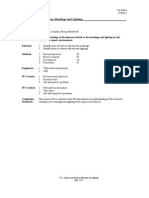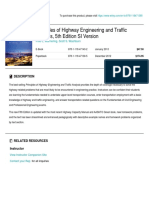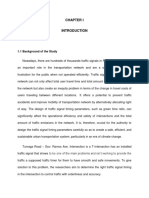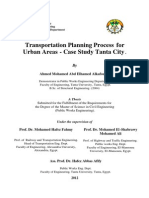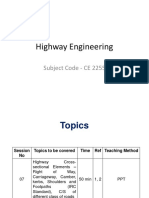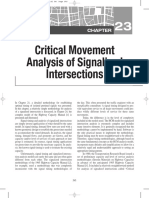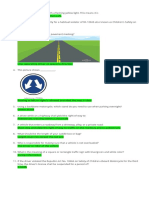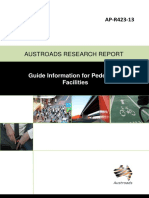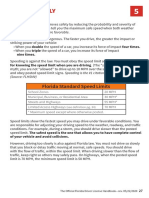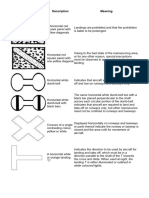C - 6-Highway Capacity and LOS - 1
C - 6-Highway Capacity and LOS - 1
Uploaded by
Durga RaiCopyright:
Available Formats
C - 6-Highway Capacity and LOS - 1
C - 6-Highway Capacity and LOS - 1
Uploaded by
Durga RaiOriginal Title
Copyright
Available Formats
Share this document
Did you find this document useful?
Is this content inappropriate?
Copyright:
Available Formats
C - 6-Highway Capacity and LOS - 1
C - 6-Highway Capacity and LOS - 1
Uploaded by
Durga RaiCopyright:
Available Formats
6/9/2014
1
Highway Capacity
And
Level of Service
capacity and LOS 1
Highway Capacity and Level of Service
Capacity and Level of service are two related
terms. Capacity analysis tries to give a clear
understanding of how much traffic a given
transportation facility can accommodate.
Level of service tries to answer how good the
present traffic situation on a given facility is.
Thus it gives a qualitative measure of traffic,
where as capacity analysis gives a quantitative
measure of a facility.
Capacity and level of service varies with the type
of facility, prevailing traffic and road conditions
etc.
capacity and LOS 2
Capacity
Capacity is defined as the maximum hourly
rate at which persons or vehicles reasonably
can be expected to traverse a point or uniform
section of a lane or roadway during a given
time period under prevailing roadway, traffic
and control condition (HCM-2000)
capacity and LOS 3
Concepts:
Maximum hourly rate: usually peak 15
minutes of the peak hour, expressed in terms
of persons or vehicles.
Prevailing conditions:
Roadway condition
Traffic conditions
Control conditions
Point or uniform section: road/facility section
should have consistent prevailing conditions.
capacity and LOS 4
6/9/2014
2
Capacity is independent of demand in the
sense that it does not depend on the total
number of vehicles demanding service.
The maximum flow rate or capacity is the
reciprocal of the minimum average headway.
Where:
C-capacity
average hmin -minimum average headway.
capacity and LOS 5
Level of service (LOS)
It is a quality measure describing operational
conditions within a traffic stream, generally in
terms of such service measures as speed and
travel times, freedom to maneuver, traffic
interruptions, comfort and convenience.
LOS determining parameters are called Measure
of Effectiveness (MOE) of that type of facility.
Each level of service represents a range of
operating conditions and the drivers perception
of those conditions
Level of service is basically step function, each
representing a range of operating conditions.
capacity and LOS 6
MOE for LOS
Uninterrupted Freeways Density (pc/km/ln)
Multilane highways Density (pc/km/ln)
Two lane highway Average travel speed (km/h)
Percent-time spent following
(%)
Interrupted Signalized intersections Control delay (sec/veh)
Unsignalized intersections total delay (sec/veh)
Arterials (urban street) Average travel speed
Pedestrians (on footpath) Space (sq ft/ped)
capacity and LOS 7
MOE
capacity and LOS 8
6/9/2014
3
Level of Service A
free-flow conditions (traffic operates at free flow speeds).
Individual users are virtually unaffected by the presence of
others in the traffic stream. Freedom to select desired speeds
and to maneuver within the traffic stream is extremely high.
The general level of comfort and convenience provided to
drivers is excellent.
capacity and LOS 9
Level of Service B
Allows speeds at or near free-flow speeds, but the presence of other users in the
traffic stream begins to be noticeable. Freedom to select desired speeds is
relatively unaffected, but there is a slight decline in the freedom to maneuver
within the traffic stream relative to LOS A.
capacity and LOS 10
Level of Service C
speeds at or near free-flow speeds, but the freedom to maneuver is noticeably
restricted (lane changes require careful attention on the part of drivers). The
general level of comfort and convenience declines significantly at this level.
Disruptions in the traffic stream, such as an incident (for example, vehicular
accident or disablement), can result in significant queue formation and vehicular
delay. In contrast, the effect of incidents at LOS A or LOS B are minimal, and cause
only minor delay in the immediate vicinity of the event.
capacity and LOS 11
Level of Service D
conditions where speeds begin to decline slightly with increasing flow. The
freedom to maneuver becomes more restricted and drivers experience
reductions in physical and psychological comfort. Incidents can generate lengthy
queues because the higher density associated with this LOS provides little space
to absorb disruption in the traffic flow.
capacity and LOS 12
6/9/2014
4
Level of Service E
represents operating conditions at or near the roadways capacity. Even minor
disruptions to the traffic stream, such as vehicles entering from a ramp or
vehicles changing lanes, can cause delays as other vehicles give way to allow
such maneuvers. In general, maneuverability is extremely limited and drivers
experience considerable physical and psychological discomfort.
capacity and LOS 13
Level of Service F
describes a breakdown in vehicular flow. Queues form quickly behind points in the
roadway where the arrival flow rate temporarily exceeds the departure rate, as
determined by the roadways capacity. Vehicles typically operate at low speeds in
these conditions and are often required to come to a complete stop, usually in a
cyclic fashion. The cyclic formation and dissipation of queues is a key
characterization of LOS F.
capacity and LOS 14
LOS can be distinguished as in the figure below
capacity and LOS 15
Factors affecting Capacity and LOS
Roadway Factors
Lane width: According to HCM a lane width of 3.6 is considered as ideal.
As lane width decreases capacity also decreases.
Lateral clearance: Such as retaining walls, abutments, sign posts, light
posts, parked cars etc. located closer than 1.8m from the edge of traffic
lane reduce the capacity.
Width of shoulder: Narrow shoulders reduce the effective width of traffic
lanes as the vehicle travel towards the center of the pavement.
Grades: Grade adversely affects the speed of the vehicles, especially
trucks and thus influence the capacity.
Presence of intersections: intersections restrict free flow of traffic and
thus adversely affect the capacity.
Alignment: Alignment and geometric (particularly sight distance) are not
of design standards, the capacity will decreases.
Surface condition: A deteriorated and poorly maintained pavement
adversely affects the capacity
capacity and LOS 16
6/9/2014
5
Factors affecting Capacity and LOS
Traffic factors
Percentage of commercial vehicles: Large commercial
vehicles like truck and buses influence the traffic stream in
two ways;
-They occupy more space than passenger cars
-They have poor operating capabilities than passenger
cars, particularly with respect to acceleration,
deceleration and ability to maintain speed in upgrades
Directional distribution
This is an important factor in case of two lane highway facility.
capacity and LOS 17
Service volume
A service volume (or service flow rate) is the
maximum number of vehicles, passengers, which can
be accommodated by a given facility or system under
given conditions at a given level of service.
Although levels of service are defined somewhat
differently, depending on the situation, they are
always intended to relate the quality of traffic service
to given volumes (or flow rates) of traffic.
Levels of service may be based on such things as
travel times (or speeds), total delay, probability of
delay, comfort, safety, and so forth.
capacity and LOS 18
A service volume (or service flow rate)
capacity and LOS 19
Types of Transport Facility
Most important classification of
transportation facilities from the engineering
perspective is based on the continuity of flow
that is uninterrupted flow and interrupted
flow.
Uninterrupted flow is the flow of traffic in
which there is no obstructions to the
movement of vehicles along the road.
Freeway is one example for this type of
facility.
capacity and LOS 20
6/9/2014
6
Freeway
In a freeway, when a vehicle enters a freeway, there
is no need for the vehicle to stop anywhere till it
leaves the freeway.
There are three sections in a freeway:
Basic unit,
Weaving section and
Ramps (on/off).
Vehicles will be entering the freeway through ramps.
Ramps are used for entering the freeway is called on-
ramps and those used for exiting the freeway are
called off ramps.
Freeways generally have 4, 6, or 8 lane alignments.
Multi lanes also provide uninterrupted flow. capacity and LOS 21
Freeway
capacity and LOS 22
Determination of the level of service
for a basic freeway section
capacity and LOS 23
Speed-flow curves for basic freeway segments
(Fig.A)
capacity and LOS 24
6/9/2014
7
Capacity of Basic Freeway Segment
Basic freeway segment capacity is the simplest highway
capacity problem covered by the Manual.
Conditions on basic freeway segments are essentially
uninterrupted one-way flow.
Under these conditions, capacity (defined by the HCM as
the maximum flow that can be sustained for 15 min) is
stated by the Manual to vary with the free-flow speed of
the freeway, and to range from
2,250 passenger cars per hour per lane (pc/h/ln) for a
free-flow speed of 90 km/h up to
2,400 pc/h/ln for free-flow speeds of 120 km/h or
more.
capacity and LOS 25
Ideal conditions
These numbers are stated to be capacities under ideal
conditions, which include
3.6 m lanes,
minimum right shoulder clearances of at least 1.8 m,
all passenger cars,
10 or more lanes (applies to urban areas only),
interchanges spaced every 3.3 km or more,
level terrain (no grades greater than 2 percent), and
a driver population consisting of regular and familiar
users of the facility.
In cases in which these conditions are not met, capacities will be
decreased.
capacity and LOS 26
Determination of the level of service
Determination of the level of service for
a basic freeway section involves
determination of the free-flow speed
FFS, the 15-min flow rate Vp.
capacity and LOS 27
FFS
The free-flow speed may be determined by either a
field study, in which speeds are measured for low to
moderate traffic volumes (up to 1,300 pc/h/ln) or by
the following formula
capacity and LOS 28
fLW - adjustment for lane width from Table C.3, km/h
fLC - adjustment for right shoulder lateral clearance from
Table C.4, km/h
fN - adjustment for number of lanes from Table C.5, km/h
fID - adjustment for interchange density from Table C.6, km/h
BFFS - base free-flow speed, 110 (urban) or 120 km/h (rural)
6/9/2014
8
Flow rate
The 15-min flow rate in pc/h/ln is calculated
from the hourly volume of mixed traffic by
capacity and LOS 29
Vp - 15-min passenger car equivalent flow rate, pc/h/ln
V - hourly volume, veh/h
PHF - peak hour factor
N - number of lanes in one direction
fHV - heavy-vehicle factor
fp - driver population factor
The peak hour factor (PHF) is defined as the ratio of
the hourly volume to the peak 15-min flow rate
The heavy vehicle adjustment factor fHV is calculated
as follows.
The HCM identifies two classes of heavy vehicles:
trucks and buses (considered to be equal in their
impact on traffic flow) and recreational vehicles.
Each heavy vehicle is thought of as being equivalent
to some number of passenger cars. These passenger
car equivalents vary with the type of heavy vehicle,
the percentage of heavy vehicles in the traffic
stream, and the length and severity of grades.
capacity and LOS 30
They are defined for both extended general
freeway segments, for which terrain is
classified as level, rolling, or mountainous
(Table C.7) and for specific combinations of
length and severity of upgrade (Tables C.8 and
C.9) and downgrade (Table C.10). The factor
fHV may be computed from individual
passenger car equivalents values as follows
capacity and LOS 31
E
T
, E
R
_ passenger car equivalents for trucks
and buses and for recreational vehicles,
respectively
P
T
, P
R
_ proportion of trucks and buses and of
recreational vehicles, respectively, in the
traffic stream
capacity and LOS 32
6/9/2014
9
The adjustment factor for driver population fp
ranges from 1.00 to 0.85.
For urban weekday traffic, fp is taken to be
1.0;
lower values may be used where evidence
exists that capacity is reduced as a result of
the presence of drivers unfamiliar with the
roadway, for instance, in recreational areas
capacity and LOS 33
S may be determined from fig. A (above)
Using the estimated free flow speed, a speed
flow curve may be constructed with the same
shape as those in fig.A. From this curve and v
p
the estimated speed S is determined.
capacity and LOS 34
Estimated speed S may be calculated as
follows:
capacity and LOS 35
Alternatively ,
and compared with the limiting values in Table
C.1 or C.2.
capacity and LOS 36
6/9/2014
10
Basic freeway segment methodology
capacity and LOS 37
PROBLEM 6.1
capacity and LOS 38
A rural freeway has an ideal free-flow speed of 120
km/h and two 3.6 m lanes in each direction, with right
shoulder lateral clearance of 1.2 m. Interchanges are
spaced approximately 5 km apart. Traffic consists of
10 percent trucks and buses and 8 percent
recreational vehicles. The adjustment for driver
population factor is estimated to be 0.90. If the
maximum 15-min flow rate is 1,760 veh/h, what is the
level of service on a 1.7 km long 3.1 percent
upgrade?
PROBLEM 6.2
An urban freeway has three 3.6m lanes in
each direction. There are no lateral
obstructions. Base free flow speed is
110km/h. Interchanges are about 1.1 km
apart. The traffic stream includes 12 percent
trucks and buses and 2 percent recreational
vehicles. If the percent peak hour volume is
2200 veh/h with PHF of 0.92, what is the level
of service on a 3 percent grade, 1.9km long.
capacity and LOS 39
You might also like
- Trip Distribution TechniquesDocument1 pageTrip Distribution TechniquesChristopher PantojaNo ratings yet
- Airport and Runway Markings and LightingDocument4 pagesAirport and Runway Markings and LightingMike Aguirre100% (1)
- 3.4 Capacity-Level-of-ServiceDocument21 pages3.4 Capacity-Level-of-ServiceMikealla DavidNo ratings yet
- Level of ServiceDocument137 pagesLevel of ServiceSyira Shuhimi0% (2)
- Capacity and Level of ServiceDocument10 pagesCapacity and Level of ServiceAbdulmajeed KandakjiNo ratings yet
- Capacity and Level of ServiceDocument16 pagesCapacity and Level of ServiceBismilNo ratings yet
- Capacity and Level of Service at SignalizedDocument20 pagesCapacity and Level of Service at SignalizedAzman Samer100% (1)
- Traffic Engineering Determination of Optimum Cycle Length-Webster's MethodDocument5 pagesTraffic Engineering Determination of Optimum Cycle Length-Webster's MethodNishanth NishiNo ratings yet
- TR3 Signalized Intersection LOS AnalysisDocument16 pagesTR3 Signalized Intersection LOS AnalysisMohamadRosli0% (2)
- 4643two Way Slabs1Document75 pages4643two Way Slabs1MILTONGALARZANo ratings yet
- Highway Chapter 3Document19 pagesHighway Chapter 3ST. JOSEPH PARISH CHURCHNo ratings yet
- Green Shields Traffic Model - 03Document11 pagesGreen Shields Traffic Model - 03Arijit GhoshNo ratings yet
- Lecture 4 Intersections Transportation EngineeringDocument38 pagesLecture 4 Intersections Transportation EngineeringIftikhar MughalNo ratings yet
- CH 12Document45 pagesCH 12hakamalramoniNo ratings yet
- Level of Service of RoadsDocument15 pagesLevel of Service of RoadsaqilahNo ratings yet
- Interrupted Flow Facilities in Which External: Excessive DelaysDocument79 pagesInterrupted Flow Facilities in Which External: Excessive DelaysBashar ArshedNo ratings yet
- CH 09 - Capacity and Level of ServiceDocument33 pagesCH 09 - Capacity and Level of ServicevictorNo ratings yet
- Wiley - Principles of Highway Engineering and Traffic Analysis, 5th Edition SI Version - 978-1-118-47139-5 - 2Document3 pagesWiley - Principles of Highway Engineering and Traffic Analysis, 5th Edition SI Version - 978-1-118-47139-5 - 2Malik ZainNo ratings yet
- Lect 3Document65 pagesLect 3Ajay KumarNo ratings yet
- Speed Spot StudiesDocument16 pagesSpeed Spot StudiesLuqman YusofNo ratings yet
- Highway II Assignment 3-1Document1 pageHighway II Assignment 3-1zakaria0% (1)
- Chapter 3.1 Geometric Design of HighwaysDocument85 pagesChapter 3.1 Geometric Design of HighwaysAmanuel AshenafiNo ratings yet
- ECE 3101 Transport Planning I Lecture 1Document13 pagesECE 3101 Transport Planning I Lecture 1Dorn AdamsNo ratings yet
- Transportation Planning - Theory PartDocument49 pagesTransportation Planning - Theory PartSagar KariyaNo ratings yet
- Chapter 1 - Traffic VolumeDocument18 pagesChapter 1 - Traffic VolumeIsuru BiyanwilaNo ratings yet
- Spot Speed StudyDocument4 pagesSpot Speed StudyGeniuskuga Kugas0% (1)
- Lecture 2-Speed StudiesDocument14 pagesLecture 2-Speed StudiesZirak M. Sarmamy100% (1)
- Geometric DesignDocument10 pagesGeometric DesignGrachelle Andrea CapiralNo ratings yet
- Traffic Volume Study 1st PartDocument7 pagesTraffic Volume Study 1st Partمھد مھيNo ratings yet
- Traffic Analysis at Signalized IntersectionDocument19 pagesTraffic Analysis at Signalized IntersectionfarahNo ratings yet
- Research Proposal - DraftDocument16 pagesResearch Proposal - DraftJdulia ClaireNo ratings yet
- Trip Generation: Source: NHI Course On Travel Demand Forecasting (152054A)Document28 pagesTrip Generation: Source: NHI Course On Travel Demand Forecasting (152054A)Erickson Cauyao100% (1)
- Transpoeng - 7.7 Modal Split AnalysisDocument4 pagesTranspoeng - 7.7 Modal Split AnalysisMarky ZoldyckNo ratings yet
- Calibration of Macroscopic Traffic Flow Model For Nepalese RoadsDocument8 pagesCalibration of Macroscopic Traffic Flow Model For Nepalese RoadsHemant TiwariNo ratings yet
- Pllaninc Transport in Egypt Ne MATLAB 2012 PDFDocument339 pagesPllaninc Transport in Egypt Ne MATLAB 2012 PDFRamadan DurakuNo ratings yet
- Highway Engineering: Subject Code - CE 2255Document43 pagesHighway Engineering: Subject Code - CE 2255HanafiahHamzahNo ratings yet
- Deatailed Methodology For Road Inventory SystemDocument3 pagesDeatailed Methodology For Road Inventory SystemSamratTalukdarNo ratings yet
- TERRAZYMEDocument36 pagesTERRAZYMEJean MbuNo ratings yet
- 8 Highway Capacity PDFDocument18 pages8 Highway Capacity PDFalogentleNo ratings yet
- Sidra Solutions - Roundabouts PDFDocument23 pagesSidra Solutions - Roundabouts PDFovidiuchirvaseNo ratings yet
- Report On RoadsDocument12 pagesReport On RoadsHidayat UllahNo ratings yet
- Chapter 1 Electronic Distance Measurement-1Document24 pagesChapter 1 Electronic Distance Measurement-1Amir Alisty0% (1)
- Reading Assignment: P. 45-72 (4 Ed.) p.45-75 (Previous Ed.) in Mannering TextbookDocument26 pagesReading Assignment: P. 45-72 (4 Ed.) p.45-75 (Previous Ed.) in Mannering TextbookMohamed Imbarek EsekbiNo ratings yet
- UEMX 3813 Highway and Transportation: Lecture 3: Highway Capacity and Level-of-Service Analysis Ir - Dr. Khoo Hooi LingDocument60 pagesUEMX 3813 Highway and Transportation: Lecture 3: Highway Capacity and Level-of-Service Analysis Ir - Dr. Khoo Hooi LingMOBA UNINo ratings yet
- Chapter 2 PDFDocument79 pagesChapter 2 PDFAnteneh GeremewNo ratings yet
- Ground WaterDocument38 pagesGround WaterUmer Yousuf ChaudharyNo ratings yet
- Directional Classified Traffic Volume Count Survey: Form: 4ADocument1 pageDirectional Classified Traffic Volume Count Survey: Form: 4ATriChandra MaharjanNo ratings yet
- Open Channels PDFDocument31 pagesOpen Channels PDFVOJNo ratings yet
- Flexible Pavement DesignDocument33 pagesFlexible Pavement DesignLalith Koushik GanganapalliNo ratings yet
- NRRS 2055first Revision 2069 DoLIDAR Reduced For WebDocument37 pagesNRRS 2055first Revision 2069 DoLIDAR Reduced For WebRazn Nhemaphuki100% (1)
- Homework No. 2Document3 pagesHomework No. 2Belal AL QaisiNo ratings yet
- CMA For Signalized Intersections by Elena PrassasDocument28 pagesCMA For Signalized Intersections by Elena PrassasCarlos MensahNo ratings yet
- Fundamental Theory of Traffic FlowDocument86 pagesFundamental Theory of Traffic FlowNSBMRNo ratings yet
- Chapter 2.0Document142 pagesChapter 2.0Firdaus NorizanNo ratings yet
- Chapter 2 Transport PlanningDocument46 pagesChapter 2 Transport PlanningGoutham DevNo ratings yet
- Chap 8Document61 pagesChap 8Mekdelawit TewodrosNo ratings yet
- Ecohydrology: Vegetation Function, Water and Resource ManagementFrom EverandEcohydrology: Vegetation Function, Water and Resource ManagementNo ratings yet
- Chapter 4 (Color)Document61 pagesChapter 4 (Color)danielNo ratings yet
- Transport Eng. Chap 4Document54 pagesTransport Eng. Chap 4yeroonrNo ratings yet
- Chapter 4Document30 pagesChapter 4Berlyn Joy QuilangNo ratings yet
- Internship Report PDFDocument46 pagesInternship Report PDFNaveen Gowda k sNo ratings yet
- Non-Pro (A) CompilationDocument12 pagesNon-Pro (A) CompilationKj VillenaNo ratings yet
- Library Study Group 1 FinalDocument1 pageLibrary Study Group 1 Finallovely kansalNo ratings yet
- Flexible Pavement Design CalculationDocument3 pagesFlexible Pavement Design CalculationSouparna Dutta100% (2)
- Traffic Management and Accident InvestigationDocument77 pagesTraffic Management and Accident Investigationarnelepil12No ratings yet
- Trumpet InterchangeDocument2 pagesTrumpet InterchangeKSHITIJ JADHAVNo ratings yet
- Kentish Town Parking LeafletDocument2 pagesKentish Town Parking Leafletgeorge.r.j.higginsNo ratings yet
- Project Sign Board DesignDocument8 pagesProject Sign Board DesignDavid LuogaNo ratings yet
- PennDOT EmailsDocument328 pagesPennDOT EmailsmegankshannonNo ratings yet
- Rerevised Schedule ADocument10 pagesRerevised Schedule Akhairul alamNo ratings yet
- Module 7 Oea StrategyDocument25 pagesModule 7 Oea StrategyFunNo ratings yet
- Chapter 5 - TrafficDocument10 pagesChapter 5 - TrafficMercy Temblor LibreNo ratings yet
- Road DesignDocument48 pagesRoad DesignshingkeongNo ratings yet
- Austroads Research Report: Guide Information For Pedestrian FacilitiesDocument96 pagesAustroads Research Report: Guide Information For Pedestrian FacilitiesNURUL ATIQAH ALINo ratings yet
- 02 DSRM Transportation PDFDocument58 pages02 DSRM Transportation PDFAlina GeorgianaNo ratings yet
- Prelim in Traffic ManagementDocument8 pagesPrelim in Traffic ManagementBea Grace VanguardiaNo ratings yet
- 24 HR Filings That Never WereDocument54 pages24 HR Filings That Never WerejmargalusNo ratings yet
- 5 - Driving SafelyDocument12 pages5 - Driving SafelyJorge LuizNo ratings yet
- Materi Suplemen 1Document43 pagesMateri Suplemen 1dinda yantiNo ratings yet
- Lecture 3+lecture 4Document16 pagesLecture 3+lecture 4Ahmad Bani YounesNo ratings yet
- Call Report: Thyssenkrupp Elevator QATARDocument3 pagesCall Report: Thyssenkrupp Elevator QATARChaimaNo ratings yet
- SignalsDocument11 pagesSignalsLlewellyn OliverNo ratings yet
- SanderoDocument3 pagesSanderoalin tmNo ratings yet
- Streetscene Highways Guide For DevelopmentDocument58 pagesStreetscene Highways Guide For DevelopmentMaria TedescoNo ratings yet
- VTPPDocument13 pagesVTPPCHATURON PRADIDPHONNo ratings yet
- WarningDocument177 pagesWarningMelvin TPNo ratings yet
- UntitledDocument26 pagesUntitledRakibul IslamNo ratings yet
- HCM 2010 - Chapter 10 Freeway FacilitiesDocument7 pagesHCM 2010 - Chapter 10 Freeway FacilitiesChristopher MohammedNo ratings yet
- ECR SR CH3 EngDocument95 pagesECR SR CH3 EngRaju KumarNo ratings yet

